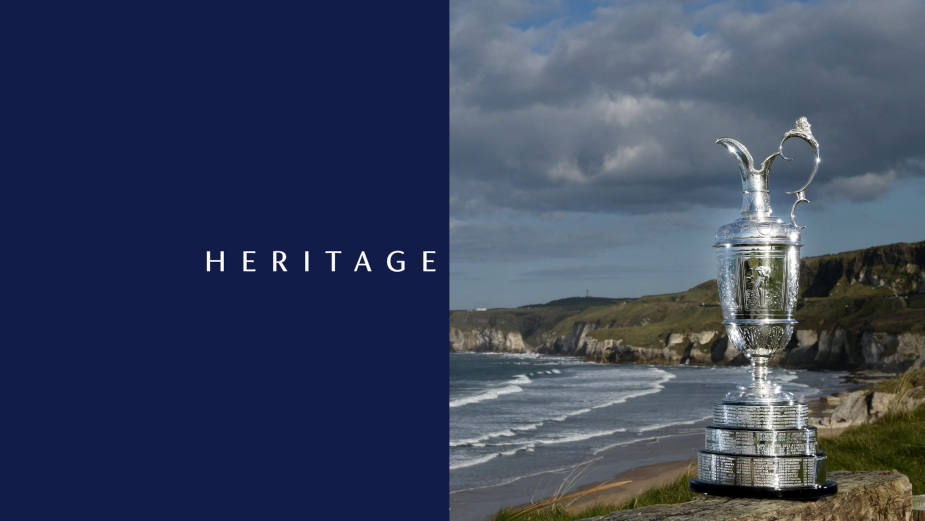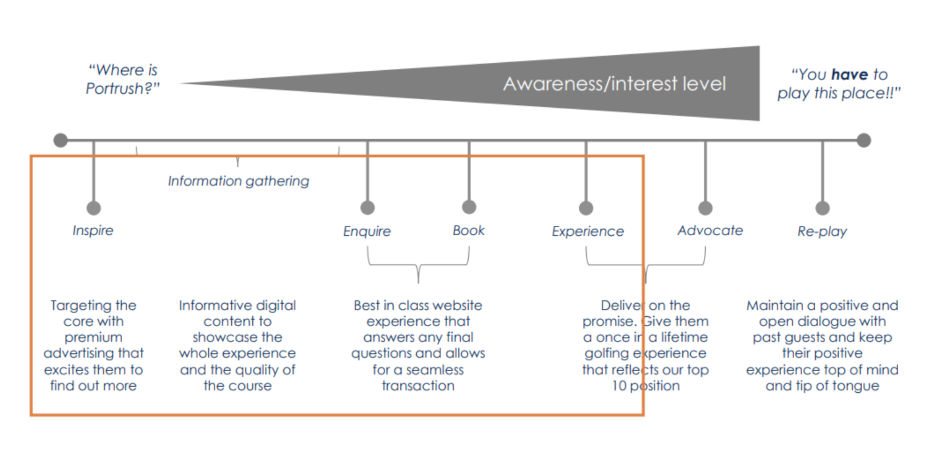
Problem Solved: How Ardmore Brought Royal Portrush into a New Era

When iconic golf course Royal Portrush wanted to launch a new website, agency Ardmore took the reins to reinvent its online presence. Here, the team break down the process.
WHAT WE MADE
Royal Portrush Golf Club is one of the biggest and best-known Golf Clubs in the world. Having previously hosted in 1951 and 2019, Royal Portrush are now hosting the 153rd Open Championship in 2025, and needed a new website that was much more reflective of their brand.
The result: Royal Portrush Golf Course is one of the most beautiful websites we have ever designed as an agency, reflecting latest web design trends and User Experience (UX) principles. It takes their brand and digital presence to the next level, giving them a solid foundation for future growth.
THE PROBLEM
The previous website was several years old and looked very dated from a design point of view. It was key to showcase the upcoming plans for The Open and the world-famous Dunluce Links course itself, along with the wider offering for visitors from other countries.
Beyond that, Royal Portrush are very progressive both in terms of their approach to sustainability and, historically, with Women in Golf. We felt that this was an important part of their DNA and worth bringing to the forefront.
To get best results for the Client, Ardmore always starts with the audience and their general awareness/interest level. Having a sense of varying degrees of warmth allows us to create beautiful content that really speaks to the end user. The initial pipeline we designed for this purpose is shown below:

During an initial planning workshop with the client, we brainstormed the content we would ideally like the website to present. It became apparent that there was actually a large list of touchpoints on which we would like to engage both members and the wider public, including The Club’s 134 Year History, the Royal Portrush Team, and the effort that goes into maintaining the club and course. We also wanted to include Royal Portrush’s plans to go carbon neutral by 2030 and its work within the community, and to showcase Portrush, Northern Ireland as an area of outstanding natural beauty.
IDEATION
To plan the solution in more detail, we created a project plan which acted as a functional specification – and described what we proposed to deliver for the client. This included an overall structure for the website, mapping out where each page should go. This involved a UX technique known as Card Sorting, where we held a workshop with the client to determine the priority order of pages/information and under which parent sections particular pages could be grouped.
In parallel to Project Planning, we started out with a look and feel design for desktop and focused on the homepage since that is where the most traffic was received. We then fleshed this out into a number of key pages, such as the About page and Course Overview, on both desktop and mobile. Once we had the general aesthetic agreed with the client, we then created a full suite of page templates for both desktop and mobile devices, mapping these onto the site structure we had previously identified.
The Ardmore Creative team were able to bring a strong vision in terms of colour scheme, typography and photography. They were able to identify at an early stage that additional photography would be required to complement the drone shots and previous photography from The Open. Ardmore were eventually able to oversee the shoot from a creative point of view.
From a UX and wider technical point of view, the Ardmore Digital team were able to provide guidance in terms of WordPress as the recommended CMS Platform. This was decided based on a number of surrounding technologies such as 2022 plans for a new Members Area and EPOS system with which the website would need to exchange information. Our technical director and web developers were also able to outline how the menus and other navigation would work in practice, and how the website could be animated in a consistent way to make the content more engaging.
A detailed Content Plan was created to advise on character limits for the areas within each page and to collect suitable imagery. The Ardmore copywriting team then reviewed all text to ensure consistency in the tone of voice used across the website. Finally, all images and text were set into the suite of page templates so that content could be reviewed in-situ ahead of the build being completed.
Using our tried and tested methods and a series of workshops, we found it straightforward to ideate around how the website would look and users would engage with the content on offer. However, there are always some ideas that get left behind.
It’s key that the messages carried by the website are reflective of an organisation’s brand and how the Client see themselves. This was particularly important to Royal Portrush when it came to the initial welcome message displayed on the website, as we needed to have something that was recognisable in terms of its DNA to members. Another challenge was how prominent to make the section on The Open. While it may be the oldest and most prestigious golf tournament in the world, Royal Portrush is about more than just one competition.
From a design point of view, we researched a number of other Golf Clubs, including Pebble Beach, St. Andrews, Wentworth and Royal Liverpool, to name a few.
PROTOTYPE & DESIGN
There were several challenges in terms of design and prototyping. First of all, we needed to find a navigation structure that would respond down well on tablet and mobile screens. This took the form of a mega menu and secondary menu bar for each parent section on desktop. However, on mobile, the menu was replaced by hamburger style menu. There was some debate over whether all sections should be made available via the hamburger menu, with expandable/collapsible sections. It was ultimately decided that, given the wide range of users and varying IT literacy, the main menu should keep the primary page structure and the secondary menu bar would be available on page as a dropdown, therefore keeping the user journey consistent across the website.
Another challenge was how to represent the 134-year history of the Club. To get an idea of the richness and scale of this history, it is useful to note that it currently exists as an A3 hardback book that is 466 pages long. From a technical point of view, we were able to create a page template within WordPress with a scrolling timeline that was also responsive on mobile. The Royal Portrush historical committee were then tasked with plotting 26 points in time that gave a broad picture of how the Club has developed over the years, and writing a summary as well as finding suitable imagery to represent each milestone.
Due to varying content, keeping a balance between design aesthetic and consistency in the user journey through a website is always one of the more challenging aspects of any web project. Creatives and those with a design background will have the best ideas about how individual pages should be presented for best aesthetic effect, while those with UX/Technical background tend to think holistically about how pages can be structured for uniformity and to allow the Client team to maintain content going forward. It often comes down to the minutiae – for example, ensuring all clickable elements use the same colour and animate the same way on rollover; or how heading tags are created in a way that is usable across a number of different page layouts while still keeping best practice Search Engine Optimisation techniques in mind.
As always when we get this kind of result in Ardmore, it was a strong team effort with a number of collaborators that have different skillsets. From Creative/Design to UX to Technical, everyone has a part to play in creating the ideal solution for the Client. The importance of effective Project Management cannot be overstated, in terms of guiding the Client through the journey and bringing these skillsets together at the right time, all the while keeping things on track in terms of timescales and budget.
One element that we wanted to try to make better use of was the 404 page. For those who aren’t in the know, the 404 page is what gets returned when a user accesses a page link that is broken or that has been closed down and not redirected to another page of relevance. Royal Portrush previously had a 404 page that displayed as a bunker affectionately referred to as Nellie and we wanted to use the opportunity to be more playful with the content of this page, while still keeping the core purpose of helping the user find their way back to the homepage.
The end result is one of those finer details that really makes a website come together in terms of user experience.

LIVE
An effective test plan is key to the success of any IT project. At Ardmore, alpha testing is carried out initially by the web developer, with peer reviews on individual features, pages and content as they are added to a solution. When the website enters into the Testing stage proper, we arrange for the more senior members of both our Creative and Web Development teams to carry out a further Quality Assurance review. Bringing the various skillsets back into the mix at this stage is crucial, because people will spot different things based on their area of expertise, as well as other factors, such as their preferred browser, mobile/tablet device or even the size of their monitor.
This process is always iterative, with tasks being raised for individual bugs or tweaks required within our project management dashboard and managed through the testing pipeline. Tasks are given a different status based on their current progress, priority level and whether the task is a bug or suggested tweak. The team are required to add as much detail as possible in terms of device/OS and what browser they are testing on, and to provide screenshots/steps to recreate the scenario where possible, to allow other team members to effectively work through their allocated tasks at greater speed. Weekly meetings are then organised by Project Managers to review the tasklist and then report back to the Client on progress along with any further input required.
All this means that, at the point of handover to the Client, we are presenting something that feels close to a final draft for the current Project phase. The hope is that we can make life easier for Clients when it comes to final approval and they are more likely to make suggestions around the fine detail that differentiates a website, as opposed to testing for bugs that we could otherwise test for ourselves.
Any web or software project will have its challenges technically. Our web developers will wrestle with the code as much as possible to get it to perform the way we all imagined it would at the Design stage of the project. We find that having global rules around styling ultimately creates a wonderful level of consistency in our CSS across many pages and avoids conflict when it comes to how the website performs responsively.
Google Analytics plays an important role in analysing how traffic flows through the website according to the key user journeys we have identified. On an ongoing basis, we analyse the most popular pages and their bounce/exit rates as well as average length of time spent on the page to determine whether the audience is being engaged effectively.
From a Search Engine Optimisation point of view, Search Console is also regularly analysed to build up a picture of what users accessing the website are organically entering into Search Engines. The page analysis tool also flags any errors on a page, so we can ensure the entire page is ranking correctly.
Feedback from Club Members and the Management team at Royal Portrush is also crucial in determining our roadmap for future integrations such as Member purse spend and discounts being applied for both online and offline orders through Club Shop.
The UX Planning used to identify touchpoints in terms of content and mapping this into a suitable website structure was an interesting challenge, particularly since there is a lot of varying content and the target audience is so vast.
Finding look and feel and navigation options that suitably reflect the Royal Portrush brand while at the same time guiding users through the website with a minimal number of clicks also feels like a major success.
From a performance standpoint, the website has been live for just over a month now and already the number of enquiries for booking tee times has increased exponentially. This is something we are especially pleased with, but we also recognise that a website is very much something that should grow and evolve over time. Future plans include integration between the Club Shop and a new EPOS system used throughout the Club, allowing for greater efficiency in terms of how orders and stock are managed.
As mentioned at the start, we at Ardmore feel we have created a beautiful web presence and one that truly reflects Royal Portrush Golf Club as a brand. Royal Portrush and their Members now have a website that showcases their status within the Golf community and it’s something everyone involved in the project is massively proud of.










